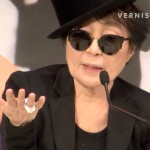Yoko Ono: This Room Moves at the Same Speed as the Clouds is an exhibition at Kunsthaus Zürich that looks back at some of the most important works of the artist. Kunsthaus curator Mirjam Varadinis, in collaboration with Yoko Ono and her long-time curator Jon Hendricks, has selected some 60 of them to arrange into an exhibition, which is titled ‘This Room Moves at the Same Speed as the Clouds’. This video provides you with an exhibition walkthrough and an introduction to the show by Mirjam Varadinis.
“I didn’t want to do some kind of historical exhibition now, a classic retrospective, but to start with her commitment against violence against women and also with her commitment for peace, and also with her very radically expanded concept of art.… The focus is on the early work, i. e. the 60s and 70s. But many of the works from back then are also being re-staged or brought to life for the exhibition.” (Mirjam Varadinis)
Yoko Ono: This Room Moves at the Same Speed as the Clouds. Kunsthaus Zürich, Zürich (Switzerland), Media Preview, March 3, 2022.
> Right-click (Mac: ctrl-click) this link to download Quicktime video file.
Media Release (excerpt):
Yoko Ono (b. 1933) is one of the most influential artists of our time. Her performances and actions of the 1960s and 1970s have achieved cult status. Some of them will be performed and exhibited at the Kunsthaus Zürich. The artist was personally involved in the exhibition’s conception.
For Peace and Women’s Rights
Since the beginning of her career, Yoko Ono has explored issues of socio-political importance that are still highly relevant today. From early on, she has been committed to peace in the world and the feminist cause. Ideas always play a central role in her work: sometimes she formulates them in a playful and humorous way, sometimes quite radically, and then again very poetically. Some are transformed into objects while others are left immaterial. Yoko Ono’s artistic oeuvre is correspondingly diverse, encompassing sculptures, works on paper, installations, performances, film and music. Kunsthaus curator Mirjam Varadinis, in collaboration with Yoko Ono and her long-time curator Jon Hendricks, has selected more than 60 of them to arrange into an exhibition.
Poetry meets Conceptual Art and Performance
Most of the works start out with ‘event scores’ or ‘instructions’, a majority of which Yoko Ono published for the first time in 1964 in the celebrated square booklet ‘Grapefruit’. This small but seminal work of conceptual art contains directions for simple actions that anyone can execute and that transform basic, everyday activities and forms of expression (such as going for a walk, striking a match or laughing) into performances. What really matters, though, is imagination: the artwork can take shape entirely in our heads, and does not necessarily have to be acted out. Yoko Ono was one of the first to write such ‘event scores’, and in doing so she radically transformed and permanently expanded the concept of art. She chose the title ‘Grapefruit’ because she saw the fruit as a hybrid, a mixture of lemon and orange. She regarded herself as a hybrid too – between Japan and America, East and West, between visual art, music and performance.
Contemporary Relevance
That multifaceted artistic practice is what gives Yoko Ono’s work its contemporary relevance, in an era when the boundaries between artistic disciplines are increasingly breaking down. The idea of the audience as performer and the everyday staging of the individual through social media are now of central importance.
Works from all Creative Periods
The exhibition at the Kunsthaus Zürich sets out to reaffirm that relevance. It shows a selection of key works from all periods of Yoko Ono’s artistic career, with a focus on the early years. The presentation is not a classical retrospective: it brings more than 60 years of artistic creativity to life from a modern-day perspective. Visitors will be able to participate in a wide variety of ways. Yoko Ono was personally involved in the conception of the exhibition.





